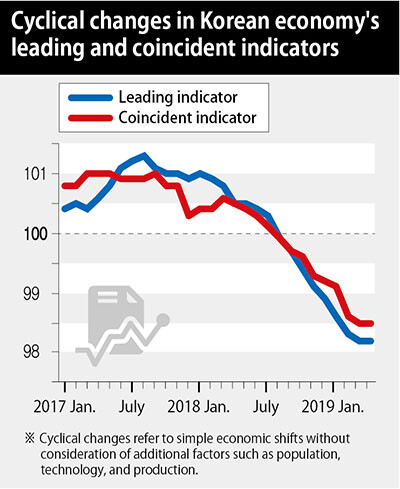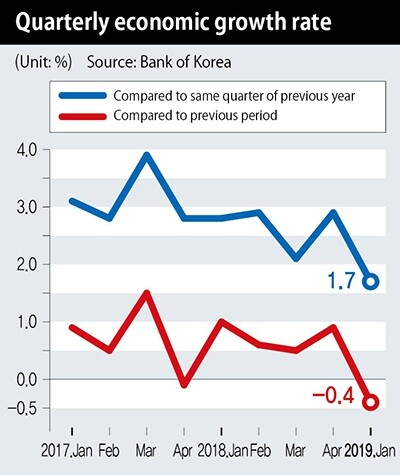hankyoreh
Links to other country sites 다른 나라 사이트 링크
KDI reports S. Korean economy has stagnated for last three months

With a supplementary budget bill for an economic stimulus package stuck in the National Assembly for 47 days amid a boycott by the opposition party, the state-funded Korea Development Institute (KDI) reported that the South Korean economy has stagnated consecutively for the last three months.
With even the Blue House previously going public with its fears that an economic recovery could be delayed, observers are voicing concerns that the economy could be in for a long-term slump if the government fails to respond in a timely way with increased fiscal spending and other means.
In a report on June economic trends released on June 10, KDI said, “A general economic slump is judged to be persisting, with exports continuing to shrink amid a slowdown in domestic demand.” The conclusion indicates that the economic slump has persisted over the three months since it was first mentioned in April.
“While the decline was reduced to some extent in April, chiefly in the areas of semiconductors and automobiles, and the service industry has grown, the rise in certain areas of production cannot be viewed as a ‘trend’ in light of fluctuations in the number of working days,” the KDI concluded. It also noted that semiconductor and petroleum exports declined in May amid a persistent trend of slowing in the global economy, adding that general trends in construction and other facility investment were weak.
Based on recent trends with economic indicators, some analysts have suggested that South Korea’s contracting economy may have hit a low. The conclusion is based on observations in the cyclical components of coincident indicators and leading indicators, which show economic trends. Both indexes halted their decline in April after decreasing for 10 consecutive months between June 2018 and March 2019.
External conditions and structural issues not favorable to economic recovery

The question is whether the economy will rebound in the second half of the year. The situation is not a favorable one. External conditions, including the trade conflict heating up between the US and China and a decline in global trade, are likely to function as drags on a rise in the economy. Some have even voiced fears of a long-term “L-shaped recession,” in which the economy fails to recover from its low.
“Owing to structural issues including the decline in the semiconductor economy, weakening competitiveness in mainstay industries, and low prices, the likelihood of the economy recovering in the second half of the year is very slight,” said Bae Min-geun, an analyst at the LG Economic Research Institute, in a telephone interview with the Hankyoreh.
“Even if certain indicators improve in the second and third quarters, the overall [slumping] trend in the economy is unlikely to change,” Bae predicted.
Experts agreed that in economic situations like the current one, the government needs to adopt a proactive policy approach of fiscal expansion. In a weekly economic commentary published on June 9, the Hyundai Research Institute concluded, “The economic low appears to fall around the second quarter of this year, and the economy current appears to be at a crossroads between recovery and recession.” As response measures by the government, the report called for efforts to identify new industries, an interest rate reduction, swift passage of the revised supplementary budget, tax cuts, and regulatory reform.
The longer the delay, the less likely the recovery
A comeback in the second half of the year appears even less likely if the government waits to begin its fiscal infusion. The main reason for the 0.4% decline in the first quarter economic growth rate compared to the quarter before was a 0.7 percentage point decrease in contributions from the government sector. This is being attributed to the failure to promptly disburse SOC investment budgets distributed to individual local governments in the first quarter. The process ended up taking place slower than expected as the different local governments developed and implemented new project plans.
It’s a situation that diminishes the likelihood of the revised supplementary budget leading to an economic recovery. When it presented its revised supplementary budget plan to the National Assembly in April 2018, the administration predicted it could increase the economic growth rate by 0.1 percentage point if implemented in a timely way. But while timing is a crucial element, the revised supplementary budget has not even come under review 47 days after its submission to the National Assembly. The Blue House’s emphasis on the risks of the economy declining further – after talking about the possibility of a recovery as recently as the middle of last month – is a signal of how serious the situation has become. In a June 7 talk with reporters, Blue House Senior Secretary to the President for Economic Affairs Yoon Jong-won stressed the importance of passing the revised supplementary budget quickly.
“There is potential for the risk of a decline in growth to persist into the long term,” he warned.
By Lee Kyung-mi, staff reporter
Please direct comments or questions to [english@hani.co.kr]

Editorial・opinion
![[Guest essay] The real reason Korea’s new right wants to dub Rhee a founding father [Guest essay] The real reason Korea’s new right wants to dub Rhee a founding father](https://flexible.img.hani.co.kr/flexible/normal/500/300/imgdb/original/2024/0423/8317138574257878.jpg) [Guest essay] The real reason Korea’s new right wants to dub Rhee a founding father
[Guest essay] The real reason Korea’s new right wants to dub Rhee a founding father![[Column] ‘Choson’: Is it time we start referring to N. Korea in its own terms? [Column] ‘Choson’: Is it time we start referring to N. Korea in its own terms?](https://flexible.img.hani.co.kr/flexible/normal/500/300/imgdb/original/2024/0423/3617138579390322.jpg) [Column] ‘Choson’: Is it time we start referring to N. Korea in its own terms?
[Column] ‘Choson’: Is it time we start referring to N. Korea in its own terms?- [Editorial] Japan’s rewriting of history with Korea has gone too far
- [Column] The president’s questionable capacity for dialogue
- [Column] Are chaebol firms just pizza pies for families to divvy up as they please?
- [Column] Has Korea, too, crossed the Rubicon on China?
- [Correspondent’s column] In Japan’s alliance with US, echoes of its past alliances with UK
- [Editorial] Does Yoon think the Korean public is wrong?
- [Editorial] As it bolsters its alliance with US, Japan must be accountable for past
- [Guest essay] Amending the Constitution is Yoon’s key to leaving office in public’s good graces
Most viewed articles
- 1[Guest essay] The real reason Korea’s new right wants to dub Rhee a founding father
- 2Senior doctors cut hours, prepare to resign as government refuses to scrap medical reform plan
- 3[Column] ‘Choson’: Is it time we start referring to N. Korea in its own terms?
- 4Why Korea shouldn’t welcome Japan’s newly beefed up defense cooperation with US
- 5Terry Anderson, AP reporter who informed world of massacre in Gwangju, dies at 76
- 6New AI-based translation tools make their way into everyday life in Korea
- 7[Column] The clock is ticking for Korea’s first lady
- 8Opposition calls Yoon’s chief of staff appointment a ‘slap in the face’
- 9[Editorial] Japan’s rewriting of history with Korea has gone too far
- 10Korean government’s compromise plan for medical reform swiftly rejected by doctors